Located at the entrance of the castle village, the museum is divided on two floors for a total of about 770 square meters in the spaces that once occupied several apartments. The complex is made up of different buildings added over time as from the fifteenth century.
On the first floor you can find the offices, the library, the deposits, the restoration workshop, the meeting room and the didactic laboratories. The ground floor comprises the exhibition for a total of about 350 square meters.
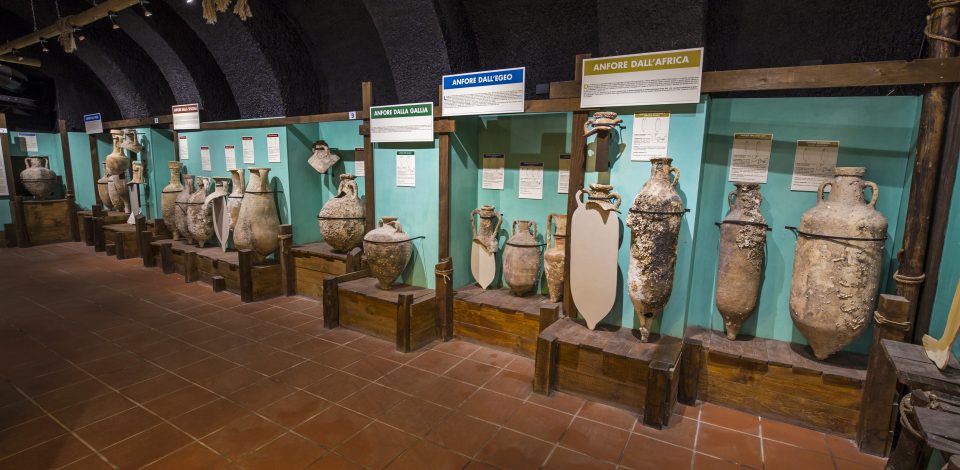
The hall brings the visitor to discover the underwater archeology, its history, methods and techniques of the underwater search, from the prospecting to the excavation. The protagonist of the hall is the large and full-size diorama that proposes a sector of an underwater archaeological excavation on the wreck of a Roman cargo ship and that reproduce the site, the underwater excavation works with the Sorbonne and the recovery of an amphora, the emerging structures of two separate wrecks, a small boat and a large ship oneraria full of amphorae and dolia, sunk one on another.
You can notice the large container rims (Dolia), the amphoras, the pottery and some on-board instruments emerging from the sand. To highlight, there are also some tools for graphic and photographic documentation of the wreck used by archaeologists (drawing board, measuring tape, ranging pole divided into centimetres).
The tour continues with a section dedicated to amphorae, “index fossil” of underwater archeology, illustrated through educational panels and a rich type of original Roman remains, dating from between the third century BC and the sixth century AD., found on the seabed of Pyrgi and ancient cerite territory, coming from Italy, Spain, Gaul, from the Aegean and northern Africa.
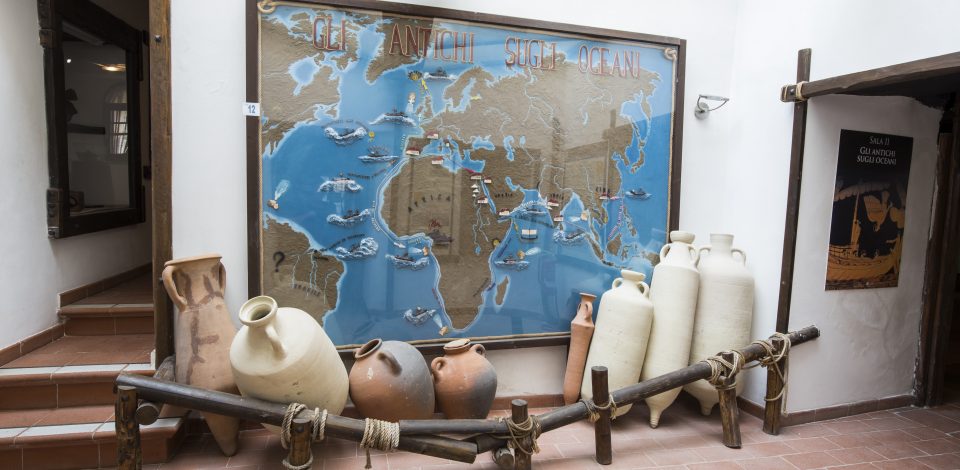
The small glass-roofed room is dedicated to the “Ancient oceans”, a fascinating and little known to the public topic, concerning the exploration and geographical discoveries of the ancient Mediterranean men.
A large model hung on the wall and some educational panels illustrate in summary the main exploratory voyages beyond the Pillars of Hercules, in the Atlantic Ocean, in the far northern seas and the Far East. The Roman amphorae models placed at the base of the plastic symbolically demonstrate the enormous development of the ancient maritime trade.
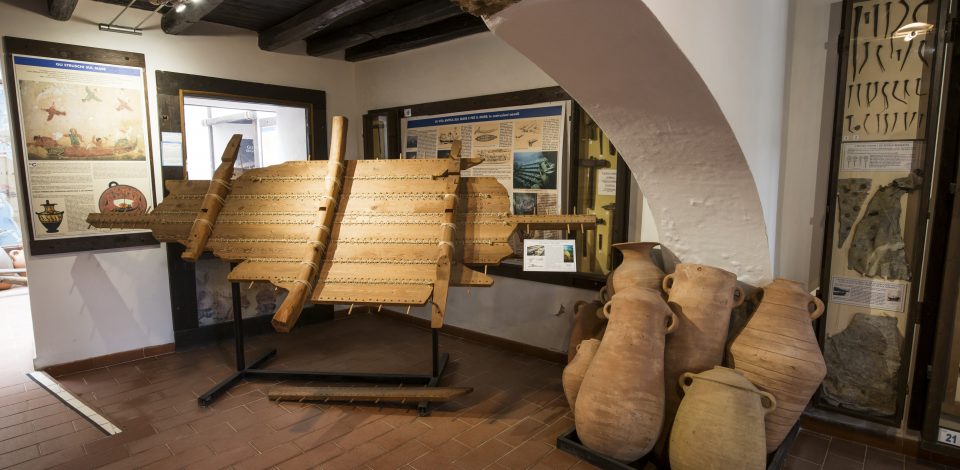
This hall introduces the construction techniques of the ancient boats: the technique of the “sewing” planking and that of the “mortise and tenon” planking. On the left you can find a replica in actual size of part of an Etruscan hull with sewn tables, while the other technique in mortise and tenon joint is represented by the portion of the hull placed at the bottom of the room to the right.
The reconstructive plastic to the right presents the port of Carthage as it was in the second century BC, just before the Roman conquest.
In the three windows in the wall there is of a collection of naval carpentry tools of the last century, which are very similar to those of the ancient times, fragments of lead sheets destined for the outer coating of the submerged part of the hull of a Roman ship, and original samples of Roman tar. Along the back wall there are several reconstructed models of archaic policies anchors and anchors with stone strain. Among the models is present the reply of the interesting anchor with ballasted lead wooden stump, found on the wreck of the Phoenician ship of Magan Mikael dating from the fifth century BC: anchor “of passage” between those with wooden stump and / or stone and those with lead strain.
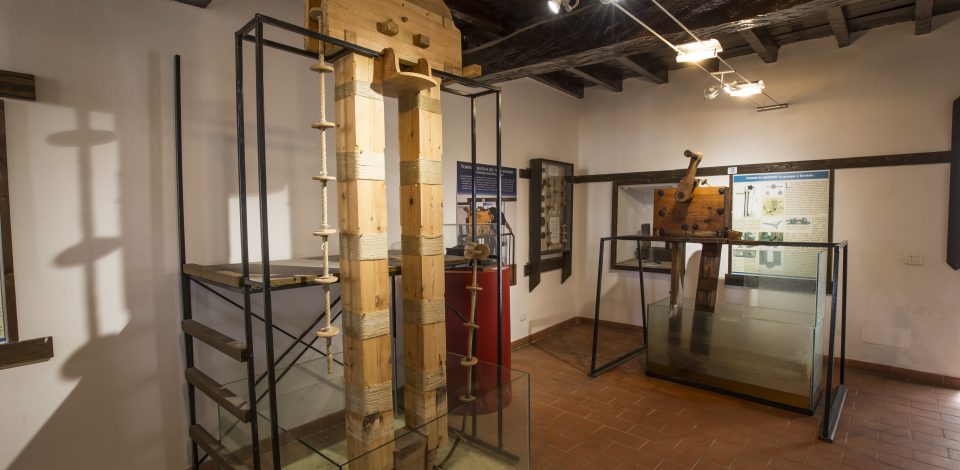
LThe room contains documents related to the bilge apparatus of the Roman ships with specific reference to the hydraulic pumps. With educational panels and reconstructed models you can learn about the water-wheel bilge pump, the bucket conveyor, the Archimedean screw pump, the piston pump.
In the middle of the room there is the model, in actual size, of the pump of the Roman ship found near the island of Ile Rousse, while to the right of the entrance you can see the working model of a Roman water wheel bilge pump: it is a unique piece, of extraordinary interest, made according to ancient techniques and materials. The work is an interesting example of reconstruction of an ancient hydraulic machine, useful to experimentally verify the method of manufacture, the operation and the relative services; of particular interest are the data relating to the experiment performed more times to verify the performance attainable with which one is able to achieve a capacity of at least 3 liters per second with an expulsion from the bilge of about 180 liters per minute.
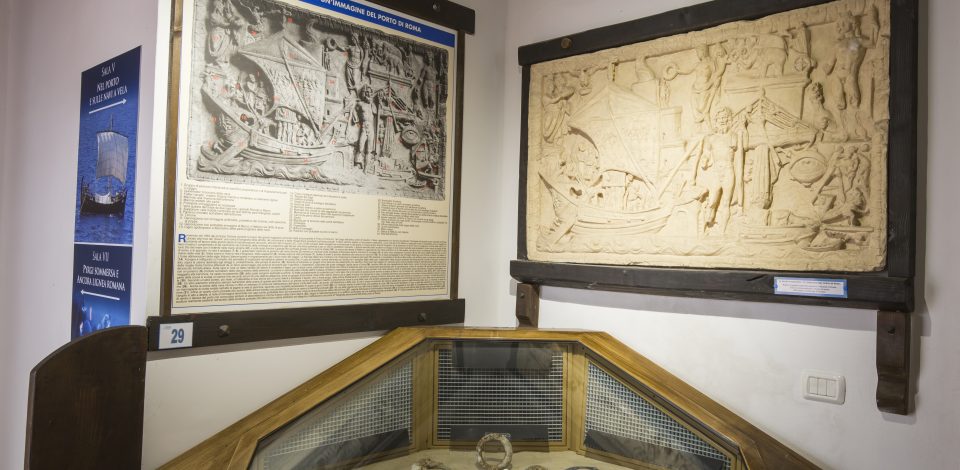
It is intended to address the topic of sailing with further details on the maneuvering and the gaits of the “square sails” ships, according to the winds and currents. At the entrance of the room, there is a faithful replica of the famous “Torlonia Relief”, a votive relief depicting the port of Rome in the early third century AD, with the image of two large onerarie ships, rich in details, the harbor lighthouse, the activities of the port and the deities that protect it: an extraordinary synthesis to learn about many aspects of the navigation and ancient life of the sea in the well illustrated adjacent educational panel.
In the room there is a model intended to illustrate all the sailing maneuvers possible for an old square-rigged ship to enter or leave a port with a given type of ground wind and, subsequently, to the true reconstruction of a hoist with a turnbuckle for sails and a documentation about sails in the classical era.
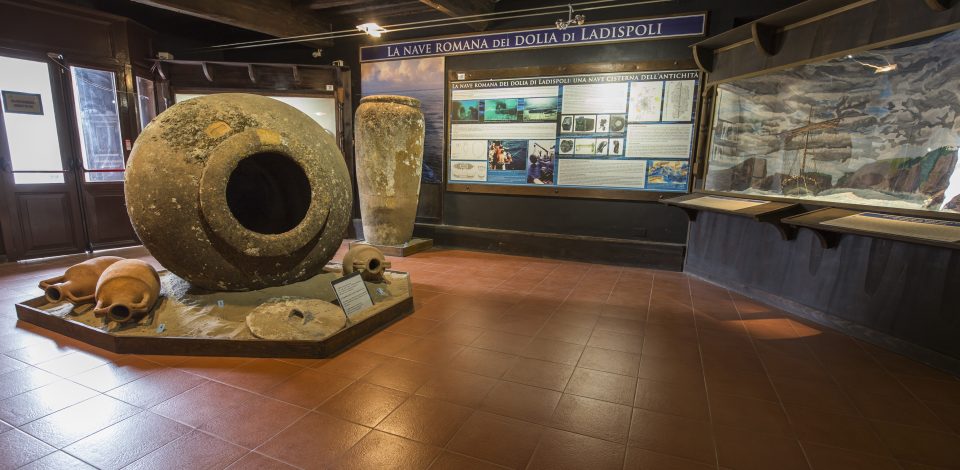
The structure of the ship proposes the use of wood species and the ancient building techniques found on the wreck of a Roman ship Laurons 2 found near Marseille. Within the hold you can notice the bilge pump, the shaft of the ship stuck in its mast step, the floor timbers and the ribs that along with the keel and the girders are the backbone of the hull. Featured below the cross-section of the hull you can see the construction technique “mortise and tenon” widespread in antiquity for shipbuilding. The internal environment consists of the figures of two sailors intent on controlling the load of amphorae and possible infiltrations in the bilge of the vessel, imagined in a difficult situation in the middle of the storm near the coast. The sound effects enhance the drama of the scene: the gubernator (helmsman), cursing, in a Latin not just Cicero, gives orders to the sailors to perform the maneuvers designed to save the ship.
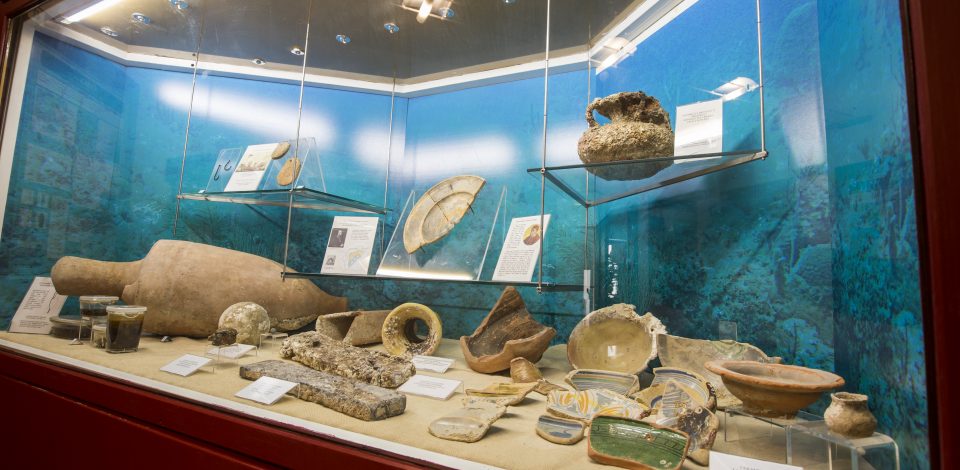
The only room to be located on the first floor, it presents the wreck of the Roman ship of Santa Severa, the current research on Pyrgi seabed and “Submerged Pyrgi” project, organized by the Museum in collaboration with the Archaeological Superintendence for Southern Etruria and the Centre of Maritime Studies and Archaeological Group of the Cerite Territory. In the window you can find some Etruscan, Roman, Medieval and Modern materials from the port channel.